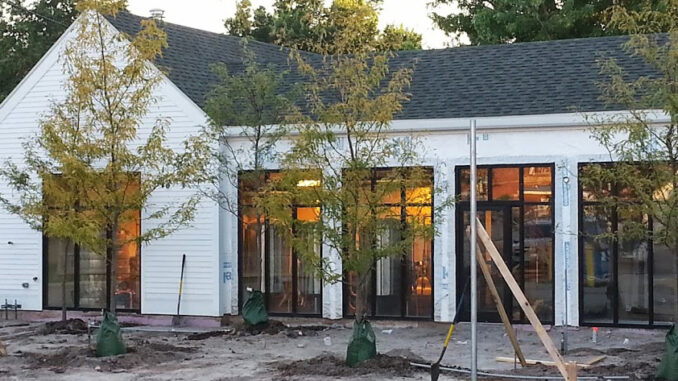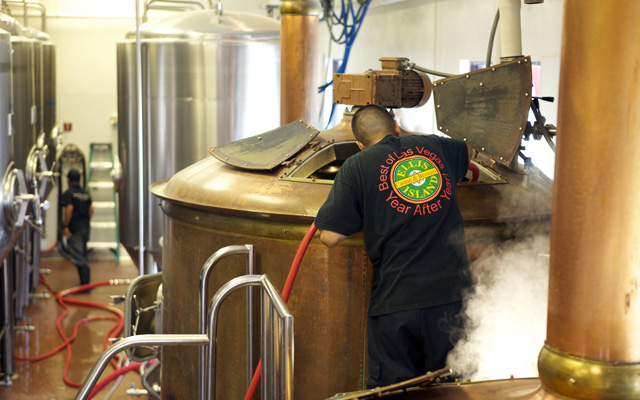
When Big Grove Brewery looked to expand production, head brewer Andy Joynt faced a familiar dilemma for many growing breweries: the high cost and long lead times tied to new equipment. Used equipment offered a faster and more affordable option, but with trade-offs that reshaped how the Iowa brewery approached its future.
“A big part of what took us to use equipment for expanding our capacity was the cost,” Joynt said during a seminar on used equipment purchasing at the 2025 Craft Brewers Conference. “Something that we were scared of with new equipment was the lead time too. When we started looking at auctions and what was available on the used market, it made it compelling on both fronts.”
Big Grove dove in headfirst, purchasing a five-vessel Mueller brewhouse at a San Diego auction. The price was low enough to set off what Joynt described as a cascade of purchases: fermenters, a centrifuge, a CIP skid, a grain-handling system, and an air compressor. Soon, 18 truckloads of stainless steel rolled from California to Iowa City. The problem was that the brewery had nowhere to put it.
“We didn’t actually have a building that all would fit inside of,” Joynt said. “We had to drop it in the parking lot of a warehouse that we owned. Then we had to add on to our building to accommodate all the tanks.”
Improvisation became the norm. Big Grove pieced together a facility with equipment sourced from as many as eight different breweries around the country. Tanks varied in size, geometry, fittings, and glycol jacket pressure. Fermenter performance differed from vessel to vessel, forcing the team to adjust processes to maintain consistency.
“Fermenter geometry was a big one for us,” Joynt said. “We had six different types of fermenters and shapes and sizes. You start to see different performance based on that, which impacts your ability to brew the brands the way you want. It introduces the opportunity to make mistakes and not be as consistent as you want to be.”
The risks Joynt experienced illustrate the broader challenges of building with used gear. Layout and design must never be an afterthought. Every square foot in a facility needs a purpose, with ergonomics, safety and maintenance considered from the start. Structural elements such as floor thickness, drainage and utilities must be evaluated early to avoid costly modifications once equipment arrives. For Big Grove, working backward from what came off the trucks was unavoidable, but it highlights why breweries weighing used equipment should expect a reverse-engineering process.
Compatibility and automation added further complexity. While fermenters and brite tanks tend to be simple, more advanced systems such as brewhouses and centrifuges can create costly problems if automation systems and PLC controls don’t integrate. Even small differences in pipe sizes and fittings can lead to unexpected welding jobs and custom fabrication that erode the initial savings.
Some issues only revealed themselves after startup. Joynt recalled a lauter tun that leaked through the floor during its first run, requiring major repair. Documentation was often missing as well, leaving the brewery scrambling to track down drawings and replacement parts. Used equipment may offer faster availability than new, but it comes with reliability risks that can absorb both money and time.
That time commitment became one of the hidden costs of Big Grove’s expansion. The team rebuilt 100 pneumatic valves by hand, gasket by gasket. While the work saved money, it demanded long stretches of repetitive labor that might have been better spent on brewing and operations. Joynt said breweries need to factor that investment of staff hours into any realistic cost analysis.
READ MORE: Cost Vs. Time — What is “Best Left to the Experts?”
For those considering the same path, vendor relationships proved crucial. Big Grove leaned on contractors and equipment specialists for repairs and retrofits, though Joynt noted that not every supplier was eager to support gear they hadn’t sold. Breweries should identify which vendors will step up on used equipment and which will not, long before placing bids at auction.
Despite the frustrations, the advantages were real. Cost savings freed up capital for other priorities. Equipment that would have taken months (or years) to arrive was in place quickly. Repurposing equipment can also align with sustainability goals by extending the life of assets that might otherwise have been scrapped. The flexibility of buying in stages allowed Big Grove to scale more dynamically than if they had committed to a turnkey buildout.
The balance between new and used ultimately comes down to strategy. If you are prioritizing efficiency and throughput, you may lean toward new systems, while those managing tight budgets or looking for speed may find the used market a smart entry point. What Joynt’s experience shows is that success with used equipment requires a willingness to adapt. The low price at auction is only the beginning. Layout, integration, and ongoing maintenance can quickly shift the financial equation if you are unprepared.
“Making sure that low, low price doesn’t come back to haunt you is the biggest piece,” Joynt said. “You’ve got to really consider the whole picture, because you’re going to make up a lot of those savings on the back end if you’re not prepared.”





Be the first to comment